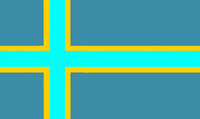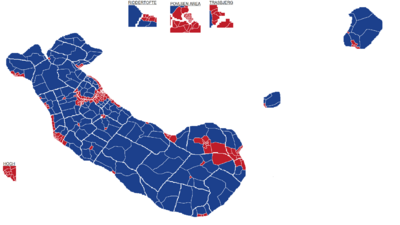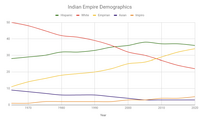Indian Empire: Difference between revisions
IndianEmpire (talk | contribs) No edit summary |
IndianEmpire (talk | contribs) No edit summary |
||
| (One intermediate revision by the same user not shown) | |||
| Line 124: | Line 124: | ||
| Minister of Foreign Affairs | | Minister of Foreign Affairs | ||
| [[Bharjak Tregster]] | | [[Bharjak Tregster]] | ||
| [[File: | | [[File:BharjakTregster2021.png|100px]] | ||
| 2009 | | 2009 | ||
|- | |- | ||
| Head of the Treasury | | Head of the Treasury | ||
| [[Bjarne Ottesen]] | | [[Bjarne Ottesen]] | ||
| [[File: | | [[File:BjarneOttesen2021.png|100px]] | ||
| 2009 | | 2009 | ||
|- | |- | ||
| Minister of Homeland Security | | Minister of Homeland Security | ||
| [[Jiang Yuhan]] | | [[Jiang Yuhan]] | ||
| [[File: | | [[File:JiangYuhan2021.png|100px]] | ||
| 2009<br />(1991-2001) | | 2009<br />(1991-2001) | ||
|- | |- | ||
| Minister of Health | | Minister of Health | ||
| [[Ella Mouritsen]] | | [[Ella Mouritsen]] | ||
| [[File: | | [[File:EllaMouritsen2021.png|100px]] | ||
| 2009 | | 2009 | ||
|- | |- | ||
| Minister of Agriculture | | Minister of Agriculture | ||
| [[Joaquin Aguinado]] | | [[Joaquin Aguinado]] | ||
| [[File: | | [[File:JoaquinAguinado2021.png|100px]] | ||
| 2020 | | 2020 | ||
|- | |- | ||
| Attorney General | | Attorney General | ||
| [[Luciana Tajdor]] | | [[Luciana Tajdor]] | ||
| [[File: | | [[File:LucianaTajdor2021.png|100px]] | ||
| 2015 | | 2015 | ||
|- | |- | ||
| Minister of Industry | | Minister of Industry | ||
| [[Nicholas Nissen]] | | [[Nicholas Nissen]] | ||
| [[File: | | [[File:NicolasNissen2021.png|100px]] | ||
| 2009<br />(1991-2001) | | 2009<br />(1991-2001) | ||
|- | |- | ||
| Minister of the Interior | | Minister of the Interior | ||
| [[Koizumi Taji]] | | [[Koizumi Taji]] | ||
| [[File: | | [[File:KoizumiTaji2021.png|100px]] | ||
| 2009 | | 2009 | ||
|- | |- | ||
| Minister of Labor | | Minister of Labor | ||
| [[Heidi Brink]] | | [[Heidi Brink]] | ||
| [[File: | | [[File:HeidiBrink2021.png|100px]] | ||
| 2013 | | 2013 | ||
|- | |- | ||
| Minister of Development | | Minister of Development | ||
| [[Zhang Xinya]] | | [[Zhang Xinya]] | ||
| [[File: | | [[File:ZhangXinya2021.png|100px]] | ||
| 2015 | | 2015 | ||
|- | |- | ||
| Minister of Transportation | | Minister of Transportation | ||
| [[Asbjørn Elkjær]] | | [[Asbjørn Elkjær]] | ||
| [[File: | | [[File:AsbjørnElkjær2021.png|100px]] | ||
| 2020 | | 2020 | ||
|- | |- | ||
| Minister of Education | | Minister of Education | ||
| [[Esmeralda Salices]] | | [[Esmeralda Salices]] | ||
| [[File: | | [[File:EsmeraldaSalices2021.png|100px]] | ||
| 2020 | | 2020 | ||
|- | |- | ||
| Minister of Energy | | Minister of Energy | ||
| [[Cecille Bisgaard]] | | [[Cecille Bisgaard]] | ||
| [[File: | | [[File:CecilleBisgaard2021.png|100px]] | ||
| 2017 | | 2017 | ||
|- | |- | ||
| Minister of Science | | Minister of Science | ||
| [[Ulla Bech]] | | [[Ulla Bech]] | ||
| [[File: | | [[File:UllaBech2021.png|100px]] | ||
| 2009 | | 2009 | ||
|- | |- | ||
| Minister of Taxation | | Minister of Taxation | ||
| [[Alma Gallo]] | | [[Alma Gallo]] | ||
| [[File: | | [[File:AlmaGallo2021.png|100px]] | ||
| 2009 | | 2009 | ||
|- | |- | ||
| Minister of Sports | | Minister of Sports | ||
| [[Taguchi Tanosuke]] | | [[Taguchi Tanosuke]] | ||
| [[File: | | [[File:TaguchiTanosuke2021.png|100px]] | ||
| 2020 | | 2020 | ||
|- | |- | ||
| Minister of the Environment | | Minister of the Environment | ||
| [[Axloven Lahjayten]] | | [[Axloven Lahjayten]] | ||
| [[File: | | [[File:AxlovenLahjayten2021.png|100px]] | ||
| 2009<br />(1991-2001) | | 2009<br />(1991-2001) | ||
|- | |- | ||
| Chief of Staff | | Chief of Staff | ||
| [[Thorvald Kirkegaard]] | | [[Thorvald Kirkegaard]] | ||
| [[File: | | [[File:ThorvaldKirkegaard2021.png|100px]] | ||
| 2015 | | 2015 | ||
|- | |- | ||
| Trade Representative | | Trade Representative | ||
| [[Bjørn Duus]] | | [[Bjørn Duus]] | ||
| [[File: | | [[File:BjørnDuus2021.png|100px]] | ||
| 2009<br />(1991-2001) | | 2009<br />(1991-2001) | ||
|- | |- | ||
| Head of Ambassadors | | Head of Ambassadors | ||
| [[Rafael Atenas]] | | [[Rafael Atenas]] | ||
| [[File: | | [[File:RafaelAtenas2021.png|100px]] | ||
| 2015 | | 2015 | ||
|- | |- | ||
| Director of Intelligence | | Director of Intelligence | ||
| [[Frida Svendsen]] | | [[Frida Svendsen]] | ||
| [[File: | | [[File:FridaSvendsen2021.png|100px]] | ||
| 2009 | | 2009 | ||
|} | |} | ||
| Line 346: | Line 346: | ||
Indian Empire initially ran on coal power for nearly 100 years, from the 1880's to 1980's. However, vastly increasing research on climate change prompted Prime Minister [[Sophie Villadsen]] to pass crucial climate change legislation that greatly regulated carbon emissions in late 1991. This caused a large transition to different power sources across the country, with northern industrial areas switching towards coal power while eastern deserts switch towards solar and wind power. A small percentage of power is still coal-powered as well. The usage of nuclear power is a topic of controversy in Empirian Politics. | Indian Empire initially ran on coal power for nearly 100 years, from the 1880's to 1980's. However, vastly increasing research on climate change prompted Prime Minister [[Sophie Villadsen]] to pass crucial climate change legislation that greatly regulated carbon emissions in late 1991. This caused a large transition to different power sources across the country, with northern industrial areas switching towards coal power while eastern deserts switch towards solar and wind power. A small percentage of power is still coal-powered as well. The usage of nuclear power is a topic of controversy in Empirian Politics. | ||
=Sports= | =Sports= | ||
[[File: | [[File:TaguchiTanosuke2021.png|200px|thumb|right|Taguchi Tanosuke, Sports Minister of Indian Empire and former Professional Football Player]] | ||
Sports are a long enjoyed past-time in Indian Empire. Many children are encouraged to join sports at a young age, as many parents believe that it pushes hard work and rewards teamwork. Professional Sports players often make millions, with many being able to make a career off the sport. | Sports are a long enjoyed past-time in Indian Empire. Many children are encouraged to join sports at a young age, as many parents believe that it pushes hard work and rewards teamwork. Professional Sports players often make millions, with many being able to make a career off the sport. | ||
Latest revision as of 03:53, 6 June 2021
The Parliamentary Republic of Indian Empire Indian Empire | |
|---|---|
|
Flag | |
| Motto: Kærlighed, Forandring og Mod | |
| Anthem: Vi Lever Alle I Harmoni | |
 | |
| Capital and largest city | Povlsen |
| Official languages | English, Spanish, Danish |
| Ethnic groups (2020) | Hispanic, Empirian, Danish |
| Demonym(s) | Empirian |
| Government | Parliamentary Republic |
• Prime Minister | Juan Rodriguez |
| Legislature | House of Commons |
| Establishment | |
• Spanish Colony | 1520 |
• Danish Colony | 1660 |
• Independence | March 29, 1965 |
| Area | |
• Total | 273,982 km2 (105,785 sq mi) |
• Water (%) | 1.22% |
| Population | |
• Estimate | 58,652,471 |
| GDP (PPP) | 2020 estimate |
• Total | 2,724,482,399,989.00 |
• Per capita | 46,451.28 |
| GDP (nominal) | 2020 estimate |
• Total | 2,724,482,399,989.00 |
• Per capita | 46,451.28 |
| Gini (2020) | 10 low |
| HDI (2020) | 0.932 very high |
| Currency | Kroner (IEK$) |
| Time zone | UTC-8 |
| Driving side | right |
| Calling code | 344+ |
| Internet TLD | .ii |
The Parliamentary Republic of Indian Empire, better known as simply Indian Empire, is a group of three islands located in the tropical Northern Pacific Ocean. The nation consists of three islands, most likely of volcanic origin, which formed around 50 years and were settled by the Impiro People. The nation became Independent of Danish Colonial Rule on 29 March 1965. The Population of Indian Empire is 58.6 Million as of the 2020 Empirian Census.
The Empirian Constitution, ratified in a 1962 Referendum, originally called for a Constitutional Monarchy, where the Danish King had some role in the country's democratic processes. However, this was overturned in a 2001 Referendum that coincided with national elections, making the nation currently a Parliamentary Republic. The current Prime Minister is Juan Rodriguez, who has served since 2015. Indian Empire is also a member of the OECD.
Indian Empire is considered to be one of the most developed nations in the world. Empirians have a very high standard of living, with the world's highest rating on the Human Development Index as well as education and healthcare. Indian Empire also has the world's highest levels of economic equality and social mobility.
Etymology
Prior to colonial rule
Prior to colonial rule, the islands were inhabited by the Impiro People.
Colonial Rule
The Impiro name first originates from Spanish colonial rule in the 15th and early 16th century, the islands initially being called "Espana Impiro" The Etymology of Indian Empire's name originates from the indigenous Impiro People , along with the Danish and Spanish History on the islands. Under Denmark, the islands were called "Dansk Indiske Impiro".
Independence
The name of Indian Empire was anglicized from "Indiske Impiro" to "Indian Empire" upon Independence from Denmark in March of 1965.
History
Early Settlements
The islands that first became Indian Empire were initially formed around 50 million years ago. It is suspected, but not confirmed, that the islands were formed as a result of volcanic activity in the Pacific. The islands were first settled by humans around 5,000 years ago by the Impiro People, who emigrated from other Pacific Islands. The Impiros spread across the central plains and eastern desert region of the main island. For close to 2,000 years, the communities remained spread out and isolated, remaining small in nature. However, around 3000 BC, the communities began to meet, establishing the Impiro Kingdom, a unification of all Impiro communities and establishing the council of Impiros, consisting of leaders of the main tribal groups. For the next 4,500 years, the Impiros lived peacefully and in harmony, farming on the land and hunting Bison, Walruses, and other animals.
Spanish Discovery
In 1517, Spanish Explorer Ramon Secada discovered the islands and the Impiro People. The Spanish later arrived on a second voyage, three years later in 1520, and established Secada Station, later known as Povlsen. According to written records, the two groups got along well, and the entire island chain was taken over by the Spanish in 1523 under the name "Espana Impiro". The Impiros helped the Spanish learn about farming & hunting on the island and the Impiros picked up Spanish.
Danish Colonial Period
In 1660, Denmark gained control over the island as a result of the Treaty of London, after the Danish and British worked together to defeat the Spanish. The land was renamed to "Dansk Indiske Impiro" and Secada Station became Povlsen. It was during Danish rule that the slave trade finally reached Indian Empire, with numerous Impiros being forced to work on Danish-owned farms. The remaining Spanish settlers often risked prosecution to keep Impiros safe over this period.
The 1848 revolutions across Europe marked substantial reforms to Danish control over Indian Empire. As a result of Denmark's transition to a Constitutional Monarchy, slavery was immediately banned across Indian Empire. A system of self-governance for the islands was also set up, with Indian Empire now being allowed to elect a territorial governor every five years. This territorial governor would be allowed to administer policy and would be the main base for communications with Denmark.
In 1940, after the Nazis defeated Denmark, Povlsen served as a temporary home for the Danish government and royal family. This was also the only major war with Indian Empire's involvement, with some units being sent to the European front. After the Nazis defeat, the Danish Government and Royals returned to Copenhagen.
In 1945, following the establishment of the United Nations, global pressure began to exist to decolonize the region. The Danish Government entered negotiations with Indian Empire in 1951, with territorial Governor Malthe Hjorth. The two parties had large disputes, namely over military bases- the Danish wanted to maintain a military presence over the island, while the Empirians largely rejected this proposal. In March 1955, Denmark was forced to sign a UN convention mandating that Indian Empire be granted independence by March of 1965, or they would face sanctions.
In 1955, the Empirians replaced Hjorth with a new territorial governor, Santiago Fonseca. Fonseca remained tough, and set up basic trade agreements with Denmark. However, Fonseca adamantly refused to allow any military presence on the island. Indian Empire ratified a constitution, which would take affect upon Independence, in 1962.
Independence
On March 29th, 1965, Indian Empire officially gained independence from Denmark. The Nations of the world rapidly began to recognize the Independence. In the nation's first election, Fonseca's Independence Party won over 80% of the vote and every seat in Parliament, making him the first prime minister of Indian Empire. During his two terms as Prime Minister, he passed a national healthcare system, and construction began on the national highway network, which would make travel through the country a lot easier. They also officially joined the Alliance of Unaligned Nations, officially taking a neutral stance on the cold war between the United States and Soviet Union. The nation's population boom, which occurred from the 1950's to 1970's, began to slow down in the 1980's. The Highway network was officially completed in 1991. Several years later, Indian Empire became a member of the Trans Pacific Partnership, a free trade agreement with the United States and numerous East Asian nations. Indian Empire became one of the first major nations to grant full equality to LGBTQ peoples and couples, doing so in 2009.
Land
Geography
Indian Empire is a very diverse nation geographically. The nation consists of three main islands. The largest island, Impiro Island, consists of multiple mountain ranges that jut out of an otherwise rather flat island. The island is also believed to be a plateau, with many parts of the island outside of the coastlines sitting 500-1500 feet above sea level. The Capital City, Povlsen is largely tucked along the coastline in the north central portions of Indian Empire. The other smaller islands, Gadbjerg and Nordoen, posess similar Geographic traits.
Climate
Much of Indian Empire's climate hinges around the varying geographical features of the country. The only locations in Indian Empire that routinely drop below O celsius are on the Northern Island of Nordoen, and snow is incredibly rare outside of these locations. Temperatures and rainfall vary greatly across the islands. In the deserts that dominate the eastern half of Impiro island, 35C is rather routine and even 45C is not entirely unheard of during the warmer months. Other regions, however, dip into single digits celsius in winter. Winter months are from December to March and Summer months are from June to September.
Environment
Indian Empire is regarded as having one of the most intact environments in the world. The natural forestry in the northern regions has been well preserved by the establishment of numerous nature reserves. The environment is very diverse. The Northern Island of Nordoen is largely dominated by tundra, while Gadbjerg and Northwestern Empiro island are largely dominanted by forested land. The Eastern half of the island is largely very arid and deserted, while the rest of Impiro Island is largely either flat and arable farmland.
Wildlife
The national animal, the Impiro Walrus, is unique to Indian Empire and is the only walrus species known outside of the artic. How this species emerged on the island is unknown, but Impiro Walruses largely flock through nature reserves in the northern half of the nation. Bears and Bison have also been prevalent throughout Indian Empire in the past, but are now near extinct on the island due to hunting.
Administrative Divisions
Indian Empire is divided into Thirty Seven Provinces and one Capital District. The Provinces generally have little lawmaking authority, but do serve to more easily describe locations in census data and when mailing, and amongst nationally managed departments serve as divisions that allow for easier administrating. Inside of these Provinces are cities. Cities have some lawmaking power, but are restricted by the limits imposed by already existing national laws. The populations of these provinces vary widely.
Politics
Politics in Indian Empire revolve around a framework established in the Empirian Constitution, which was ratified in 1962. It established a constitutional monarchy, with the Danish Monarch as Head of State. It established a unicameral legislature, known as the House of Commons, a 387 member legislative body of which the selected Speaker would become Prime Minister. This constitution has been amended several times, notably removing the Monarch's role in 2001, and establishing the Cube Root Rule for the number of seats in 2019, and decreasing the voting age in 1991.
Government
The Empirian Government consists of a singular, Unicameral Legislature known as the House of Commons. As of 2020, this legislature contains a total of 389 members, who each represent roughly 150,000 citizens. The House of Commons is responsible for legislating the law, is responsible for the national budget, approving of treaties with foreign nations, and exercising the government's powers. Outisde of the legislature, a cabinet exists, which are voted on in the party's leadership elections along with the standing candidate for Prime Minister. This cabinet consists of a total of 22 offices, all of which must be members of parliament. Indian Empire is a parliamentary democracy with Universal Suffrage. It has one of the lowest voting ages in the world, with citizens being allowed to vote at the age of majority- which has been 16 since independence and the voting age since 1991. Members of the House of Commons are elected through First Past the Post voting in a total of 389 districts, with the most seats dictating control of the legislature. This party's majority leader, who is the house speaker that introduces bills, is the Prime Minister of Indian Empire. Previously, snap elections were allowed to be requested upon a vote of no confidence, however, this system was eliminated with the elimination of the Danish Monarch's role in Empirian Democracy, and elections have occurred every four years since 2001.
In the most recent elections, which occurred in July of 2017, Indian Empire's Social Democratic Party, led by Prime Minister Juan Rodriguez, lost a total of 21 Parliament seats, but retained a majority in the house of commons, 220 to 167. Following the expansion of Parliament in 2020, two special elections that occurred were both won by the Social Democrats, who currently hold a 222-167 majority. The next elections will occur in 2021.
Cabinet
The Cabinet consists of a total of 22 officials, who serve in the House of Commons. They are elected through a party election every five years, where the prime minister and other cabinet officials are selected. The cabinet officials are headed by the prime minister, Juan Rodriguez, who has served since 2015. The second highest minister is the Chief of Staff, Thorvald Kirkegaard, who runs with the Prime Minister and helps manage cabinet duties.
Officials
| Position | Person | Photo | Since |
|---|---|---|---|
| Prime Minister/Speaker | Juan Rodriguez | 
|
2015 |
| Minister of Foreign Affairs | Bharjak Tregster | 
|
2009 |
| Head of the Treasury | Bjarne Ottesen | 
|
2009 |
| Minister of Homeland Security | Jiang Yuhan | 
|
2009 (1991-2001) |
| Minister of Health | Ella Mouritsen | 
|
2009 |
| Minister of Agriculture | Joaquin Aguinado | 
|
2020 |
| Attorney General | Luciana Tajdor | 
|
2015 |
| Minister of Industry | Nicholas Nissen | 
|
2009 (1991-2001) |
| Minister of the Interior | Koizumi Taji | 
|
2009 |
| Minister of Labor | Heidi Brink | 
|
2013 |
| Minister of Development | Zhang Xinya | 
|
2015 |
| Minister of Transportation | Asbjørn Elkjær | 
|
2020 |
| Minister of Education | Esmeralda Salices | 
|
2020 |
| Minister of Energy | Cecille Bisgaard | 
|
2017 |
| Minister of Science | Ulla Bech | 
|
2009 |
| Minister of Taxation | Alma Gallo | 
|
2009 |
| Minister of Sports | Taguchi Tanosuke | 
|
2020 |
| Minister of the Environment | Axloven Lahjayten | 
|
2009 (1991-2001) |
| Chief of Staff | Thorvald Kirkegaard | 
|
2015 |
| Trade Representative | Bjørn Duus | 
|
2009 (1991-2001) |
| Head of Ambassadors | Rafael Atenas | 
|
2015 |
| Director of Intelligence | Frida Svendsen | 
|
2009 |
Judiciary
The Empirian Legal System is headed by the five seat Empirian Supreme Court. Similar to the American and British law systems, Indian Empire has case-based law, where past legal precedent from older cases forms the basis for Empirian Law.
Indian Empire has 1 National Supreme Court, One court in each of the 37 Provinces, and numerous city and local courts. Many of these courts handle lesser cases, which may be chosen by the Supreme Court to be heard upon appeals. The justices on the Empirian Supreme Court are typically appointed by a line of succession, with ideological equality amongst the appointees.
Population
Demographics
The Population of Indian Empire, according to the 2020 Empirian National Census was 58,672,471- making it the 24th most populous country on earth, just below Italy and above South Africa. The average age in Indian Empire is 35.4 years, with 0.98 males per female. The population is increasing at a rate around 1.02%. Indian Empire is typically regarded as one of the world's happiest nations, due to high quality healthcare and education as well as low income inequality.
Indian Empire has historically been ethnically diverse, having been so since at least the 1700's. Up from the 1700's until Independence in the 1960's, the nation was majority white and largely of Danish ancestry. Ever since then, Indian Empire has gotten ever increasingly diverse. As of the 2020 Census, Indian Empire is Plurality Hispanic (36%), with native Empirians at 34%. 22% of the population is White. 5% of the Population is Indigenous Impiro and 3% are Asian. Immigration in the modern day to Indian Empire is rare- most emigration, however, occurs from familial connections (marrying into an Empirian family) and this emigration tends to come from the western world.
Languages
English, Danish, and Spanish are each heavily prevalent within Indian Empire. Danish and Spanish have been the main initial languages. However, after Indian Empire's Independence, English began to emerge as a necessary language for international communication. In the present day, English is the most prevalent language, but Danish and Spanish are both learned by Empirian students. 95% of Empirians speak English, and roughly 60% know Danish and 40% Spanish. Many know at least two, if not all three of these.
Religion
Indian Empire is rather atheistic, with most Empirians not practicing a singular religion. Amongst those who practice, though, Christianity, and more specifically Catholicism, is the most popular religion. Folk Religions, from the indigenous Impiro people, consist of 4-5% of the population and is the second largest practiced religion. Indian Empire also has small Hindu, Buddhist, Muslim, and Jewish religious groups. Church attendance is considered very low in Indian Empire, one of the lowest rates in the world, primarily because of greater focus on Education, Sports, and other events.
Largest Cities
| Rank | City | Province | 2015 Pop. | 2020 Census |
|---|---|---|---|---|
| 1 | Povlsen | Capital District | 4,442,809 | 4,536,020 |
| 2 | Hjaremaal | Høgh | 1,203,581 | 1,263,448 |
| 3 | Riddertofte | Espersen | 857,480 | 861,489 |
| 4 | Trasbjerg | Schou | 789,682 | 813,663 |
| 5 | Holmstol | Sletter | 722,105 | 736,959 |
| 6 | Christiansfeld | Christiansfeld | 587,819 | 588,684 |
| 7 | Saltune | Nordøstkyst | 533,813 | 576,688 |
| 8 | Skovsende | Andersen Halvøen | 528,573 | 522,699 |
| 9 | Udstolpe | Schou | 427,164 | 436,927 |
| 10 | Stevnstrup | Svingelbjerg | 399,280 | 436,176 |
Policy
Economy
Indian Empire's economy has a GDP of roughly 2.724 trillion dollars, making it the 7th largest economy in the world, right below the United Kingdom but right above France. The GDP per capita of 46,451 dollars ranks Indian Empire 17th, above Germany and below San Marino. For a long time, this economy has been primarily based on farming and manufacturing. Farming is still prevalent in rural areas in the central areas of Impiro Island, and though not as prevalent as it once was, Indian Empire is the 2nd largest global producer of agricultural goods. Manufacturing has held some prevalence in Indian Empire since at least the 1940's, however, Indian Empire's entry into the Trans-Pacific Partnership in 1994 has caused a strong decline in manufacturing from peak, along with rapidly increasing environmental protections passed in the last 30-40 years. However, within Indian Empire, tourism is beginning to rapidly grow, with many Tourists visiting Povlsen and other large cities in recent years to learn about Empirian culture, attend sporting events, or relax on Indian Empire's pristine beaches.
Indian Empire's currency, the Krone ($IEK) is considered rather strong on the global stage, with 1.94 Empirian Krone equaling 1 US Dollar, a similar exchange rate to that of the modern European Union.
Taxation and Welfare
Indian Empire is known for its expansive welfare state, and as a result, taxes are rather high- total tax revenue for the Government as of 2019 was 50% of the national GDP. However, this revenue is put into a variety of causes, including welfare programs. Notably, Indian Empire's Social Security program, which takes money out through taxes and pays it back upon a person's retirement (provided they are 62 or older). Indian Empire also provides for poverty programs, food stamps, and other basic welfare programs.
Labor
Indian Empire is considered to have strong worker protection laws. The rights to a union are protected by law, and many workers actively participate in a Union. Indian Empire is also considered free market in nature. Indian Empire operates with a 12 krone/hour minimum wage, and industry unions are primarily responsible for negotiating worker raises with companies. Empirians are paid equally regardless of gender, and religion, identity, sexuality, and other factors are not permissable reasons to not hire or fire a employee.
Unemployment benefits in Indian Empire are comprehensive and make up for 75% of the previous wage you received, so long as you are actively looking for work. Otherwise, unemployment benefits are capped at 50% of your wage when you were fired.
Education
Education in Indian Empire is entirely public and is centralized at the national level. Most Empirian Students attend school from ages 4-16, however some are allowed (and successfully able to) test onto accelerated paths that allow them to complete school before 16. Many cover a standard ciriculum, with many standard, required courses in math, science, history, and language, especially in secondary school. Tertiary School (College, occurs between 16-20 years of age and sometimes lower) tends to be the most specialized, with students picking a major or field of specialization for a career. All of these schools are public run and free of charge. Standards are managed by minister Esmeralda Salices.
Empirian students do not often encounter tests, as schools primarily base themselves around motivation of hard work rather than knowledge. In spite of this, Indian Empire has rather high standardized test scores compared to other OECD countries. Empirian students are required to graduate secondary school, however, tertiary school completion rates are largely based on the student's career choice, in spite of free tuition to all attending students.
Students in Indian Empire, beginning in secondary school, are required to complete a full credit (two semesters worth) of Math, Science, History, Physical Education, and Language classes, along with an elective, to complete each school year. Classes are largely taught in English, however, Danish and Spanish may also be interchangeable depending on location, as these are learned alongside English in Language class. The school year traditionally goes from Early September to Mid-May. Choices about school uniforms are largely left to the local level, however, most schools implement a dress code that allows most types of clothing to be worn on school grounds. All Rehabilitation Academies in Indian Empire, which students are sent to upon expulsion, have uniforms, but vary in design.
Health
As of 2020, Indian Empire has a lifespan of 85 years (84 for men and 86 for women), which is one of the world's highest. Many experts credit this high lifespan to the Empirian Healthcare system, a single payer, fully government run program that provides healthcare access to each Empirian. This healthcare system is fully comprehensive and includes all kinds of medical care, ranging from check-ups to specialized doctors.
Indian Empire's high lifespan is also attributed to Empirians healthy lifestyle, where studies suggest that more than 90% of Empirians exercise for at least one hour a day, many suggesting an improvement after Physical Education became a required class yearly in 1992 as establishing such as a habit at a young age. Diagnosis rates for many common health problems, such as asthma, tend to be higher than the OECD average, but this is often attributed to the healthcare system, allowing for regular, yearly physicals, and in many cases such being required under the law.
Transportation
Indian Empire has a highly developed transport network. Perhaps the earliest cross-country transportation route was the Trans-Empirian Railway, which was built in the 1880's and 1890's and is also the origin for immigration to Indian Empire from Asian countries. Basic road systems were mainly built in the early 1900's that allowed for travel easily within cities.
Transportation really began to boom after Indian Empire's independence in 1965. Quickly after this, many large cities began to develop metro networks within city limits, with some even expanding to metro areas. Meanwhile, Prime Minister Santiago Fonseca quickly established the Empirian Highway System, a large, fast network of roads that connects all corners of the country in a quick and efficient manner. This highway system as planned in the 1966 bill was finally completed in full in the early 1990's.
However, Cars are not an extremely common form of transport within cities, and they tend to be used for driving longer distances or in rural areas. Within cities, the underground metro system is traditionally more frequent, in addition to walking and even cycling.
The implementation of high speed rail nationally has been proposed but has not came to fruition. The Social Democratic Party supports High speed rail on the platform for the 2021 General Election.
Technology
Indian Empire has been historically technologically advanced, often gaining access to developing technologies early on. In March 2020, Indian Empire became the first country to guarantee broadband access to every citizen by law. In addition to this, it is estimated that roughly 99% of Empirians have a cell phone and that roughly 98.5% have a Personal Computer at home. Empirians do still maintain active cable subscriptions, but a good chunk of the cost has been cut due to streaming services. However, cable is largely kept for access to a wide array of sporting events.
The most notable technology invented in Indian Empire was the HMbox, a gaming console released into the market in 2019 by HM Gaming. The HMbox was built with compatability for multiple consoles at once, including the Xbox and Playstation, and the games are played through a player worn bodysuit that detects the movements. This console originally retailed at a very expensive price, but the price has been brought down drastically due to low sales and the HMbox has began to gain popularity amongst Empirians in 2020.
Energy
Indian Empire initially ran on coal power for nearly 100 years, from the 1880's to 1980's. However, vastly increasing research on climate change prompted Prime Minister Sophie Villadsen to pass crucial climate change legislation that greatly regulated carbon emissions in late 1991. This caused a large transition to different power sources across the country, with northern industrial areas switching towards coal power while eastern deserts switch towards solar and wind power. A small percentage of power is still coal-powered as well. The usage of nuclear power is a topic of controversy in Empirian Politics.
Sports
Sports are a long enjoyed past-time in Indian Empire. Many children are encouraged to join sports at a young age, as many parents believe that it pushes hard work and rewards teamwork. Professional Sports players often make millions, with many being able to make a career off the sport.
Empirians most enjoy Football (known as Soccer to Americans), which is the national sport. Indian Empire is also most successful in this sport- despite having never won the world cup, they have placed 3rd once (1998) and 2nd once (2010). The Empirian Premier League is the highest soccer league, featuring 30 different clubs. Below them are two additional divisions and numerous secondary leagues. Basketball is incredibly popular and follows a similar structure, headed by the Empirian Basketball Association. Beyond these, the most popular sports are Water Sports and Track & Field. Water Sports are incredibly common, as swimming is taught in schools at a young age. Many dedicated Empirians also take a second sport to work on skills for a primary sport- amongst these, Gymnastics is popular for arm strength, ballet is popular for flexibility and leg strength, Track is popular for speed, etc.
Empirians are typically strong contenders in a variety of sports. They are downright dominant in Badminton and handball, and good at a variety of other sports including baseball, basketball, soccer, golf, gymnastics, and water polo. Empirians typically manage to win a few medals every olympics and compete in major tournaments in these sports.






